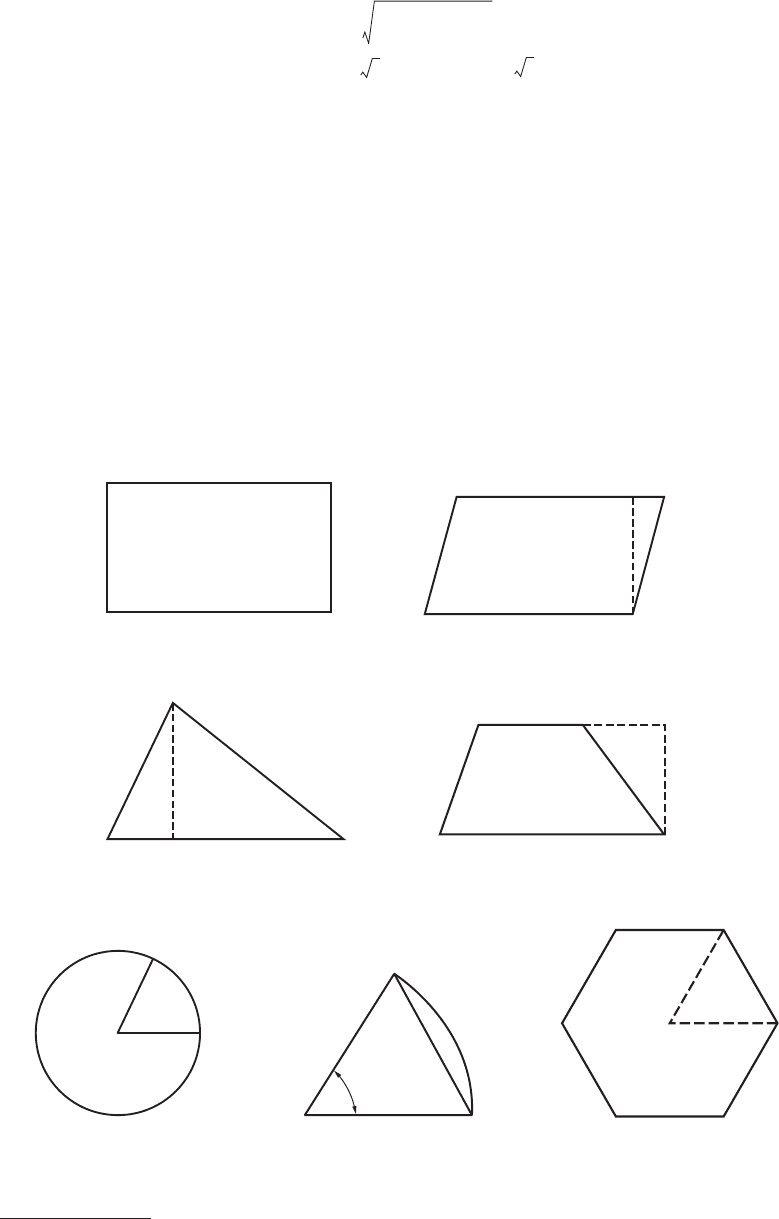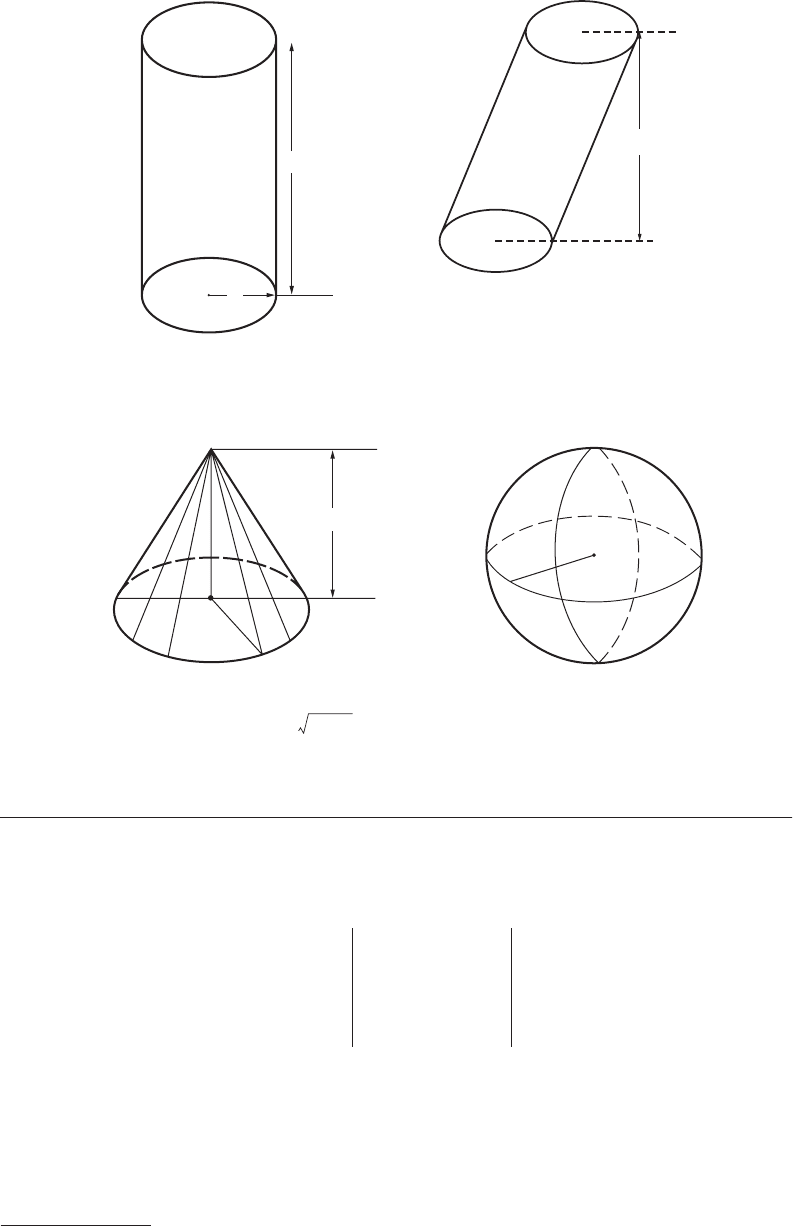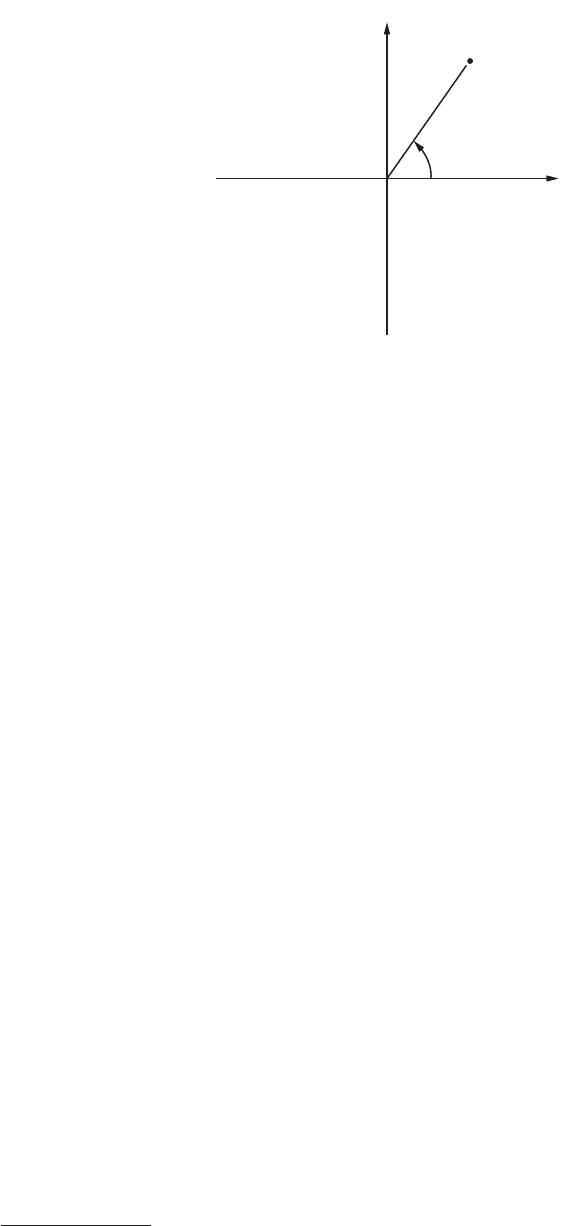Wai-Fah Chen.The Civil Engineering Handbook
Подождите немного. Документ загружается.


© 2003 by CRC Press LLC
When (1/27)p
3
+ (1/4)q
2
is negative, A is complex; in this case A should be expressed in trigono-
metric form: A = r (cos θ + i sin θ), where θ is a first- or second-quadrant angle, as q is negative or
positive. The three roots of the reduced cubic are
Geometry
Figures 2 to 12 are a collection of common geometric figures. Area (A), volume (V ), and other measurable
features are indicated.
FIGURE 2 Rectangle. A = bh. FIGURE 3 Parallelogram. A = bh.
FIGURE 4 Triangle. A = 1/2 bh. FIGURE 5 Trapezoid. A = 1/2 (a + b)h.
FIGURE 6 Circle. A = πR
2
;
circumference = 2
πR; arc
length
S = Rθ (θ in radians).
FIGURE 7 Sector of circle.
A
sector
= 1/2 R
2
θ; A
segment
=
1/2
R
2
(θ – sin θ).
FIGURE 8 Regular polygon of n
sides. A = n/4 b
2
ctn π/n; R = b/2
csc
π/n.
B
1
2
--
q– 127⁄()p
3
1
4
--
q
2
+–=
W
1– i 3+
2
-----------------------
W
2
,
1– i 3–
2
----------------------= =
y
1
2 r()
13⁄
θ
3⁄()cos=
y
2
2 r()
13⁄
θ
3
--- 120°+
cos=
y
3
2 r()
13⁄
θ
3
--- 240°+
cos=
b
h
h
b
h
b
h
b
a
R
S
θ
R
θ
θ
R
b

© 2003 by CRC Press LLC
Determinants, Matrices, and Linear Systems of Equations
Determinants
Definition. The square array (matrix) A, with n rows and n columns, has associated with it the determinant
a number equal to
where i, j, k, K, l is a permutation of the n integers 1, 2, 3, K, n in some order. The sign is plus if the
permutation is
even and is minus if the permutation is odd. The 2 × 2 determinant
FIGURE 9 Right circular cylinder. V
= π R
2
h; lateral surface area = 2π Rh.
FIGURE 10 Cylinder (or prism)
with parallel bases.
V = A/t.
FIGURE 11 Right circular cone. V = 1/3 πR
2
h;
lateral surface area =
πRl = πR
FIGURE 12 Sphere. V = 4/3 πR
3
;
surface area = 4
πR
2
.
R
h
h
A
h
I
R
R
R
2
h
2
+ .
det A
a
11
a
12
L a
1n
a
21
a
22
L a
2n
L L L L
a
n1
a
n2
L a
nn
=
±()a
1i
a
2j
a
3k
K
a
nl
∑

© 2003 by CRC Press LLC
has the value a
11
a
22
– a
12
a
21
since the permutation (1, 2) is even and (2, 1) is odd. For 3 × 3 determinants,
permutations are as follows:
Thus,
A determinant of order n is seen to be the sum of n! signed products.
Evaluation by Cofactors
Each element a
ij
has a determinant of order (n – 1) called a minor (M
ij
), obtained by suppressing all
elements in row
i and column j. For example, the minor of element a
22
in the 3 × 3 determinant above is
The cofactor of element a
ij
, denoted A
ij
, is defined as ± M
ij
, where the sign is determined from i and j:
The value of the n × n determinant equals the sum of products of elements of any row (or column)
and their respective cofactors. Thus, for the 3
× 3 determinant
or
etc.
Properties of Determinants
a. If the corresponding columns and rows of A are interchanged, det A is unchanged.
b. If any two rows (or columns) are interchanged, the sign of det A changes.
1, 2, 3 even
1, 3, 2 odd
2, 1, 3 odd
2, 3, 1 even
3, 1, 2 even
3, 2, 1 odd
a
11
a
12
a
21
a
22
a
11
a
12
a
13
a
21
a
22
a
23
a
31
a
32
a
33
a+
11
.
a
22
.
a
33
a–
11
.
a
23
.
a
32
a
12
–
.
a
21
.
a
33
a
12
+
.
a
23
.
a
31
a
13
+
.
a
21
.
a
32
a
13
–
.
a
22
.
a
31
=
a
11
a
13
a
31
a
33
A
ij
1–()
ij+
M
ij
=
det Aa
11
A
11
a
12
A
12
a
13
A
13
first row()++=
a
11
A
11
a
21
A
21
a
31
A
31
first column( )++=

© 2003 by CRC Press LLC
c. If any two rows (or columns) are identical, det A = 0.
d. If A is triangular (all elements above the main diagonal equal to zero), A = a
11
⋅ a
22
⋅ K ⋅ a
nn
:
e. If to each element of a row or column there is added C times the corresponding element in another
row (or column), the value of the determinant is unchanged.
Matrices
Definition. A matrix is a rectangular array of numbers and is represented by a symbol A or [a
ij
]:
The numbers a
ij
are termed elements of the matrix; subscripts i and j identify the element as the number
in row
i and column j. The order of the matrix is m × n (“m by n”). When m = n, the matrix is square
and is said to be of order
n. For a square matrix of order n, the elements a
11
, a
22
, K, a
nn
constitute the
main diagonal.
Operations
Addition. Matrices A and B of the same order may be added by adding corresponding elements, i.e.,
A + B = [(a
ij
+ b
ij
)].
Scalar multiplication. If A = [a
ij
] and c is a constant (scalar), then cA = [ca
ij
], that is, every element
of
A is multiplied by c. In particular, (–1)A = – A = [– a
ij
], and A + (– A ) = 0, a matrix with all
elements equal to zero.
Multiplication of matrices. Matrices A and B may be multiplied only when they are conformable,
which means
that the number of columns of A equals the number of rows of B. Thus, if A is m ×
k and B is k × n, then the product C = AB exists as an m × n matrix with elements c
ij
equal to the
sum of products of elements in row
i of A and corresponding elements of column j of B:
For example, if
then element c
21
is the sum of products a
21
b
11
+ a
22
b
21
+ K + a
2k
b
k1
.
a
11
0 0 L 0
a
21
a
22
0 L 0
L L L LL
a
n1
a
n2
a
n3
L a
nn
A
a
11
a
12
L a
1n
a
21
a
22
L a
2n
L L L L
a
m1
a
m2
L a
mn
a
ij
[]= =
c
ij
a
il
b
lj
l 1=
k
∑
=
a
11
a
12
L a
1k
a
21
a
22
L a
2k
L L L L
a
m1
L L a
mk
b
11
b
12
L b
1n
b
21
b
22
L b
2n
L L L L
b
k1
b
k2
L b
kn
⋅
c
11
c
12
L c
1n
c
21
c
22
L c
2n
L L L
c
m1
c
m2
L c
mn
=

© 2003 by CRC Press LLC
Properties
Transpose
If A is an n × m matrix, the matrix of order m × n obtained by interchanging the rows and columns of
A is called the transpose and is denoted A
T
. The following are properties of A, B, and their respective
transposes:
A symmetric matrix is a square matrix A with the property A = A
T
.
Identity Matrix
A square matrix in which each element of the main diagonal is the same constant a and all other elements
are zero is called a
scalar matrix.
When a scalar matrix is multiplied by a conformable second matrix A, the product is aA, which is the
same as multiplying
A by a scalar a. A scalar matrix with diagonal elements 1 is called the identity, or unit,
matrix and is denoted
I. Thus, for any nth-order matrix A, the identity matrix of order n has the property
Adjoint
If A is an n-order square matrix and A
ij
is the cofactor of element a
ij
, the transpose of [A
ij
] is called the
adjoint of A:
Inverse Matrix
Given a square matrix A of order n, if there exists a matrix B such that AB = BA = I, then B is called the
inverse of A. The inverse is denoted A
–1
. A necessary and sufficient condition that the square matrix A
have an inverse is det A ≠ 0. Such a matrix is called nonsingular; its inverse is unique and is given by
AB+ BA+=
ABC+()+ AB+()C+=
c
1
c
2
+()Ac
1
Ac
2
A+=
cA B+()cA cB+=
c
1
c
2
A() c
1
c
2
()A=
AB()C() ABC()=
AB+()C() AC BC+=
AB BA in general( )≠
A
T
()
T
A=
AB+()
T
A
T
B
T
+=
cA()
T
cA
T
=
AB()
T
B
T
A
T
=
a 0 0 L 0
0 a 0 L 0
0 0 a L 0
L L L L
0 0 0 L a
AI IA A==
adj AA
ij
[]
T
=

© 2003 by CRC Press LLC
Thus, to form the inverse of the nonsingular matrix A, form the adjoint of A and divide each element
of the adjoint by det
A. For example,
Therefore,
Systems of Linear Equations
Given the system
a unique solution exists if det A ≠ 0, where A is the n × n matrix of coefficients [a
ij
].
Solution by Determinants (Cramer’s Rule)
where A
k
is the matrix obtained from A by replacing the kth column of A by the column of bs.
A
1–
adj A
det A
--------------=
102
31– 1
456
has matrix of cofactors
11– 14– 19
10 2– 5–
251–
adjoint =
11– 10 2
14– 2– 5
19 5– 1–
and determinant 27=
A
1–
11–
27
--------
10
27
-----
2
27
-----
14–
27
--------
2–
27
------
5
27
-----
19
27
-----
5–
27
------
1–
27
------
=
a
11
x
1
a
12
x
2
L a
1n
x
n
b
1
=+ ++
a
21
x
1
a
22
x
2
L a
2n
x
n
b
2
=+ ++
M MMM M
a
n1
x
1
a
n2
x
2
L a
nn
x
n
b
n
=+ ++
x
1
b
1
a
12
L a
1n
b
2
a
22
MM M
b
n
a
n2
a
nn
det A÷=
x
2
a
11
b
1
a
13
L a
1n
a
21
b
2
LL
MM
a
n1
b
n
a
n3
a
nn
det A÷=
M
x
k
det A
k
det A
----------------=

© 2003 by CRC Press LLC
Matrix Solution
The linear system may be written in matrix form AX = B, where A is the matrix of coefficients [a
ij
] and
X and B are
If a unique solution exists, det A ≠ 0; hence, A
–1
exists and
Trigonometry
Triangles
In any triangle (in a plane) with sides a, b, and c and corresponding opposite angles A, B, and C,
(Law of Sines)
(Law of Cosines)
(Law of Tangents)
If the vertices have coordinates (x
1
, y
1
), (x
2
, y
2
), and (x
3
, y
3
), the area is the absolute value of the
expression
X
x
1
x
2
M
x
n
B
b
1
b
2
M
b
n
= =
XA
1–
B=
a
Asin
-----------
b
Bsin
-----------
c
Csin
-----------==
a
2
b
2
c
2
2cb cos A–+=
ab+
ab–
------------
1
2
---
AB+()tan
1
2
---
AB–()tan
--------------------------------=
1
2
--
Asin
sb–()sc–()
bc
------------------------------= where s
1
2
--
abc++()=
1
2
--
Acos
ss a–()
bc
-----------------=
1
2
--
Atan
sb–()sc–()
ss a–()
------------------------------ =
Area
1
2
--
bc Asin=
ss a–()sb–()sc–() =
1
2
--
x
1
y
1
1
x
2
y
2
1
x
3
y
3
1

© 2003 by CRC Press LLC
Trigonometric Functions of an Angle
With reference to Figure 13, P(x, y) is a point in either one of the four quadrants and A is an angle whose
initial side is coincident with the positive
x-axis and whose terminal side contains the point P(x, y). The
distance from the origin
P(x, y) is denoted by r and is positive. The trigonometric functions of the angle
A are defined as
z-Transform and the Laplace Transform
When F(t), a continuous function of time, is sampled at regular intervals of period T, the usual Laplace
transform techniques are modified. The diagramatic form of a simple sampler, together with its associated
input–output waveforms, is shown in Figure
14.
Defining the set of impulse functions δ
τ
(t) by
the input–output relationship of the sampler becomes
While for a given F(t) and T the F
*
(t) is unique, the converse is not true.
FIGURE 13 The trigonometric point. Angle A is taken to be positive when the rotation is counterclockwise and
negative when the rotation is clockwise. The plane is divided into quadrants as shown.
Y
X
A
0
P(x, y)
r
(I)(II)
(III) (IV)
Asin e A sin yr⁄= =
Acos cosine A xr⁄= =
Atan tangent A yx⁄= =
ctn A cotangent Axy⁄= =
sec A secant Arx⁄= =
csc A cosecant Ary⁄= =
δ
τ
t()
δ
tnT–()
n 0=
∞
∑
≡
F
*
t() Ft()
δ
τ
t()⋅=
FnT()
δ
tnT–()⋅
n 0=
∞
∑
=

© 2003 by CRC Press LLC
For function U(t), the output of the ideal sampler U
*
(t) is a set of values U(kT ), k = 0, 1, 2, …, that is,
The Laplace transform of the output is
FIGURE 14
Sampler
Period T
F*
(
t
)
F
(
t
)
F*
(
t
)
t
t
the sampling frequency
1
T
≡
F
s
U
*
t() Ut()
δ
tkT–()
k 0=
∞
∑
=
L
+ U
*
t(){}e
st–
U
*
t()td
0
∞
∫
e
st–
Ut()
δ
tkT–()
k 0=
∞
∑
td
0
∞
∫
= =
e
skT–
UkT()
k 0=
∞
∑
=
Atan
1
ctn A
--------------
Asin
Acos
--------------==
Acsc
1
Asin
-------------=
Asec
1
cos A
--------------=
ctn A
1
tan A
--------------
cos A
sin A
--------------==
sin
2
A cos
2
A+ 1=
1 tan
2
A+ sec
2
A=
1 ctn
2
A+ csc
2
A=
AB±()sin A B A cos± Bsincossin=
AB±()cos Acos B Asin
+
−
Bsincos=
AB±()tan
Atan Btan±
1 A Btantan
+
−
---------------------------------------=

© 2003 by CRC Press LLC
2Asin 2 A Acossin=
3Asin 3 A 4sin
3
A–sin=
nAsin 2 n 1–()A An2–()Asin–cossin=
2Acos 2cos
2
A 1– 12sin
2
A–= =
3Acos 4cos
3
A 3 Acos–=
nAcos 2 n 1–()A An2–()Acos–coscos=
A Bsin+sin 2
1
2
--
AB+()
1
2
--
AB–()cossin=
A Bsin–sin 2
1
2
--
cos AB+()
1
2
--
sin AB–()=
A Bcos+cos 2
1
2
--
cos AB+()
1
2
--
cos AB–()=
A Bcos–cos 2–
1
2
--
sin AB+()
1
2
--
sin AB–()=
A Btan±tan
AB±()sin
A Bcoscos
------------------------------=
ctn A ctn B±
AB±()sin
sin A sin B
----------------------------
±=
ABsinsin
1
2
--
AB–()cos
1
2
--
– AB+()cos=
cos ABcos
1
2
--
AB–()cos
1
2
--
AB+()cos+=
ABcossin
1
2
--
AB+()sin
1
2
--
AB–()sin+=
A
2
---
sin
1 Acos–
2
-----------------------±=
A
2
---
cos
1 Acos+
2
-----------------------±=
A
2
---
tan
1 Acos–
Asin
-----------------------
Asin
1 Acos+
-----------------------
1 Acos–
1 Acos+
-----------------------±= = =
sin
2
A
1
2
--
12Acos–( )=
cos
2
A
1
2
--
12Acos+( )=
